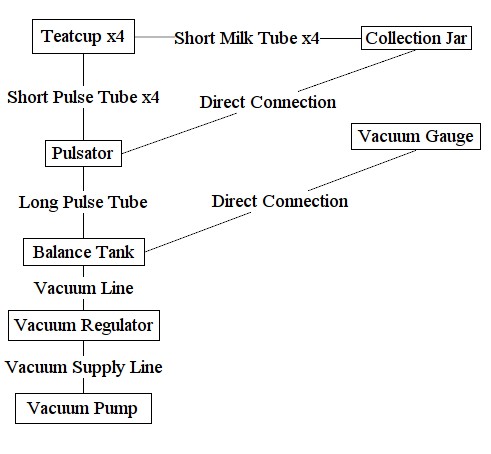Dairy Milker/Research Development: Difference between revisions
Jump to navigation
Jump to search
No edit summary |
|||
| Line 31: | Line 31: | ||
*See page 8 of link "Milking and Milk Quality" for a full diagram | *See page 8 of link "Milking and Milk Quality" for a full diagram | ||
*'''Simplified Dairy Milker''' | |||
[[File:dairymilkeroverview.jpg]] | |||
===Milking Unit=== | ===Milking Unit=== | ||
Revision as of 20:30, 7 September 2011
| Dairy Milker | ||
|---|---|---|
| Home | Research & Development | Bill of Materials | Manufacturing Instructions | User's Manual | User Reviews | 
| |
Research
Wanted: Brief description about the highest version of the GVCSTool
Theory
Wanted: Brief paragraph regarding the reasoning behind adding this tool to the GVCS
Relevant Links
Building Your Own Dairy Milking Unit
Conceptual Notes
Wanted: Ifs, ands and buts.
Development
Overview
- Milking Unit are the components that attach to the dairy cow and produce pulses for alternating vacuum/atmospheric air entry cycles
- Vacuum System is the components that produce and regulate the vacuum level
- Milk Flow System is the components that accumulate milk and pump it to a bulk tank
- See page 8 of link "Milking and Milk Quality" for a full diagram
- Simplified Dairy Milker
Milking Unit
- Includes the pulsator, teatcups, short and long milk tubes, short and long pulse tubes, and the claw.
- Claw
- Simply a component that connects ports to more ports
- From 1 port for the long milk tube to 4 ports for the short milk tubes
- From 1 port for the long pulse tube to 4 ports for the short pulse tubes
- Teatcup
- The teatcup is comprised of a shell and liner, the liner being attached to the dairy cow's teats during the milking process.
- Do we want metal or hard plastic teat cup shells? Assume stainless steel for its durability
- Do we want rubber or silicone teat cup liners? Assume silicone for its durability
- Do we want an integrated or separate short milk tube? Assume separate
- The teatcup has an opening for the short milk tube, one for the short pulse tube, and one for the liner mouthpiece
- The teatcup liner is comprised of a mouthpiece and barrel
- Pulsator
- Small machine that alternates between applying vacuum at the teatcups and admitting air at atmospheric pressure to the teatcups
- Normal pulsator rate (rate of opening and closing) is 60 per minute. Pulsation ratio (vacuum time to air entry time) can be 50:50.
- 1 port to pulse line to vacuum reservoir
- 1 port to long pulse tube to claw
- 1 port to atmosphere
- Runs on DC current, usually 12V or 24V
Vacuum System
- Vacuum Gauge
- Placed inline with the pulsation lines and also between the vacuum reserve tank and vacuum regulator
- Measures vacuum pressure
- 2 ports
- Vacuum Reserve Tank
- Distributes vacuum to the pulsation header lines and milk header line
- Buffers the vacuum level for when air enters the vacuum system
- 1 port for milk header line
- 2 ports for pulsation header lines
- 1 port for main vacuum supply line
- Vacuum Pump Filter
- Prevents particulates from entering the vacuum pump
- 1 port for intake to main vacuum supply line
- 1 port for outtake to line to vacuum pump
- Vacuum Pump
- Applies a partial vacuum in the system
- 1 external port
- 1 vacuum port
- Vacuum Regulator
- Prevents vacuum level from increasing excessively by allowing air into the vacuum system when the vacuum level reaches a preset value
- 1 external port
- 2 inline ports
- Vacuum Relief Valve
- Prevents vacuum level from increasing excessively by allowing air into the vacuum system when the vacuum level reaches a preset value in case the vacuum regulator fails
- 1 external port
- 2 inline ports
- Sanitary Trap
- Separates the air-only vacuum system from the milk collection system
- Prevents liquid and particulates from the milk collection system entering the vacuum system
- 1 port to vacuum system
- 1 port to milk flow system
Milk Flow System
- Milk Receiver Jar
- Collects milk from the milking units
- 1 port to vacuum system
- 2 ports to milk pipelines
- 1 port to milk pump
- Milk Pump
- Pumps milk from the milk receiver jar to the bulk tank
- 1 port to milk receiver jar
- 1 port to milk filter
- Milk Filter
- Prevents particulates from entering bulk tank
- 1 port to milk pump
- 1 port to bulk tank
- Bulk Tank
- Main collection container for milk
- 1 port to milk filter
- 1 port to sink for yielding milk
Design
- Requirements
- Speed
- Throughput
- Weight
- Size Constraints
- Feed stock
- Design Description
- Calculations
- Drawings and Diagrams
- Concept and Alternatives
- Full Design Views
- Cut-away Views
- Exploded Parts View
- 3D Renders
- Decisions
- Project Team
Industry Standards
| Industry Standard | GVCSTool |
|---|
Funding
Wanted: List of expenses for prototyping and documenting GVCSTool
Peer Reviews
Wanted: Peer reviews from the scientific community regarding the R&D of GVCSTool
Experiments and Prototypes
Wanted: Empirical data on performance
